
Quillaja saponaria, the soap bark tree or soapbark, is an evergreen tree in the family Quillajaceae, native to warm temperate central Chile. In Chile it occurs from 32 to 40° South Latitude approximately and at up to 2000 m (6500 ft) above sea level. It can grow to 15–20 m (50–65 ft) in height. The tree has thick, dark bark; smooth, leathery, shiny, oval evergreen leaves 3–5 cm long; white star-shaped flowers 15 mm diameter borne in dense corymbs; and a dry fruit with five follicles each containing 10–20 seeds. The tree has several practical and commercial uses.

Jubaea is a genus of palms with one species, Jubaea chilensis, commonly known in English as the Chilean wine palm or Chile cocopalm, and palma chilena in Spanish. It is native to southwestern South America and is endemic to a small area of central Chile between 32°S and 35°S in southern Coquimbo, Valparaíso, Santiago, O'Higgins, and northern Maule regions.

La Campana National Park is in the Cordillera de la Costa, Quillota Province, in the Valparaíso Region of Chile. La Campana National Park and the Vizcachas Mountains lie northwest of Santiago. This national park covers approximately 80 square kilometres (31 sq mi) and is home to one of the last palm forests of Jubaea chilensis, which prehistorically had a much wider distribution than at present. Another attraction is the Cerro La Campana, which lends its name to the park. In 1834 Charles Darwin climbed this mountain, during the second voyage of HMS Beagle.
La Campana-Peñuelas is a Biosphere Reserve located in west-central Chile. which includes La Campana National Park and the Lago Peñuelas National Reserve. Forests within the La Campana-Peñuelas are habitats for the Chilean Wine Palm, Jubaea chilensis, an endangered palm, which had a much broader distribution prior to modern times.

Maytenus boaria (mayten) is an evergreen tree of the family Celastraceae, native from South America, up to 20 m (66 ft), 80 cm (31 in) diameter, straight trunk. It occurs naturally approximately from 30 to 50°S: Chile.

Kageneckia oblonga is a species of plant in the family Rosaceae. It is endemic to Chile. K. oblonga is an evergreen tree. It grows from Coquimbo to Malleco. Example occurrences are found specifically found in central Chile within the La Campana National Park and Cerro La Campana forest areas. In these areas the endangered Chilean Wine Palm, Jubaea chilensis is an associated tree species.
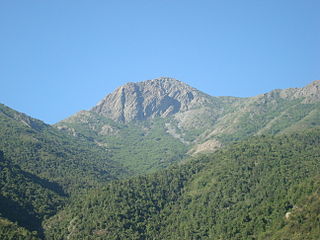
Cerro la Campana, the Bell mountain, is a mountain in La Campana National Park in central Chile. The Pacific and the mountain Aconcagua are visible from the summit on clear days.
The Vizcachas Mountains is a mountain range northwest of Santiago, in the Santiago Metropolitan Region, Chile. It is part of the Chilean Coast Ranges System.
The Ocoa Valley is a landform in central Chile located by the La Campana National Park. This valley is a locus where considerable archaeological recovery has taken place, yielding considerable finds of pre-European contact period. According to Dallman and Hogan, some of the greatest stands of the endangered Chilean Wine Palm, Jubaea chilensis are found on the slopes of La Campana that rise up from the Ocoa Valley.
Adiantum gertrudis is a threatened species of ferns in the Vittarioideae subfamily of the Pteridaceae that occurs in central South America. One locus of occurrence of A. gertrudis is within central Chile at the La Campana National Park. A morphological trait unique to A. gertrudis is the hairs covering its fronds.
Puya coquimbensis is a species in the family Bromeliaceae. This species is a rare plant found in certain portions of Chile including Punta Teatinos and Cerro La Campana. In La Campana National Park P.coquimbensis is associated with the endangered Chilean Wine Palm, Jubaea chilensis, which palm prehistorically had a much wider distribution.

Porlieria chilensis is a plant that occurs in South America. In fact, all genus members are small trees or shrubs found on the South American continent. An example occurrence of P. chilensis is in the arid forested area of central Chile, where it occurs in association with the endangered Chilean wine palm, Jubaea chilensis.
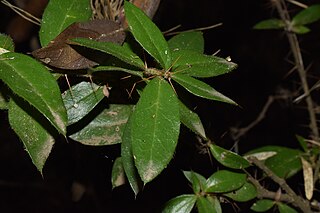
Dasyphyllum excelsum is a species of flowering plant in the family Asteraceae. This species is endemic to Chile, occurring from Quillota to Cauquenes between 190 and 800 m above sea level, a specific location of occurrence being in central Chile within the Cerro La Campana forests in association with the endangered Chilean wine palm, Jubaea chilensis.
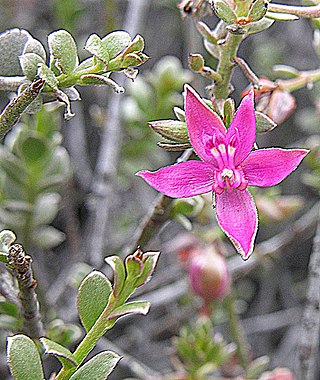
Krameria cistoidea is a perennial shrub in the plant family Krameriaceae. The biological action of genus members is caused by the astringent rhataniatannic acid, which is similar to tannic acid. Members of Krameria are found across the Americas, with most native to the tropical regions. An example occurrence is in the Cerro La Campana of central Chile, where it is found in association with the Chilean Wine Palm, Jubaea chilensis. They are perennial shrubs which act as root parasites on other plants. The flowers have glands called elaiophores which produce a lipid which is collected by bees of the genus Centris as they pollinate the flowers.
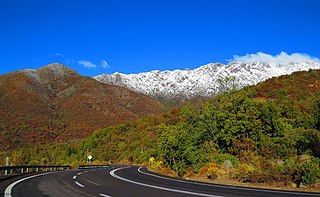
Cuesta La Dormida is a mountain in central Chile. Some of the forested mountain area of Cuesta La Dormida has been added to the La Campana National Park in order to achieve protection for the Jubaea and other endangered species. Forests on Cuesta La Dormida provide habitat for a number of bird and mammal species in addition to the flora mosaic itself.
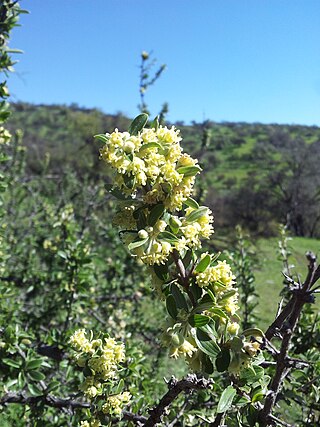
Trevoa is a genus of actinorhizal plants; these dicotyledon flora are trees or small shrubs. The genus was first proposed by Miers in 1825, but was not fully described until 1830 by Sir William Jackson Hooker. Genus members are notable for their ability to fix nitrogen. Species of this genus are generally found in the near coastal forests and arid shrubland of South America. Some species are localized in the mountains of central Chile; for example, the species Trevoa trinervis occurs in the La Campana National Park and other proximate areas of central Chile.
Adesmia resinosa is a species of flowering plant in the legume family, Fabaceae. It belongs to the subfamily Faboideae. The species is found in portions of South America, with an example location being La Campana National Park in central Chile as an understory associate of the Chilean wine palm.
Myrceugenia correifolia is a species of evergreen woody flowering shrub belonging to the Myrtle family, Myrtaceae. The common name of this plant is petrillo. The species is native to South America; an example occurrence is in central Chile within the La Campana National Park.
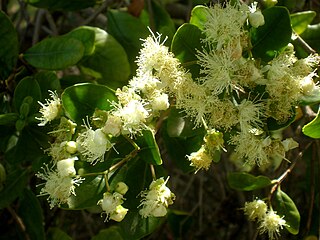
Myrceugenia exsucca is an evergreen woody flowering plant species of the Myrtle family, Myrtaceae. The species is native to South America as far south as Chile. An example occurrence is in central Chile within the La Campana National Park. A common name for this tree is petra.
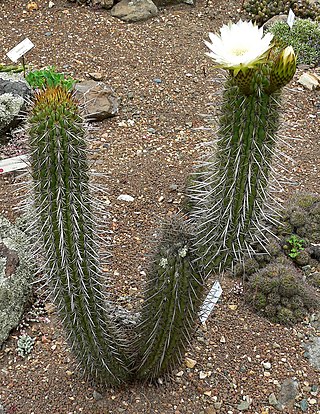
Leucostele chiloensis is a species of cactus native to South America; genus members are known as hedgehog cacti, sea-urchin cactus or Easter lily cactus.













